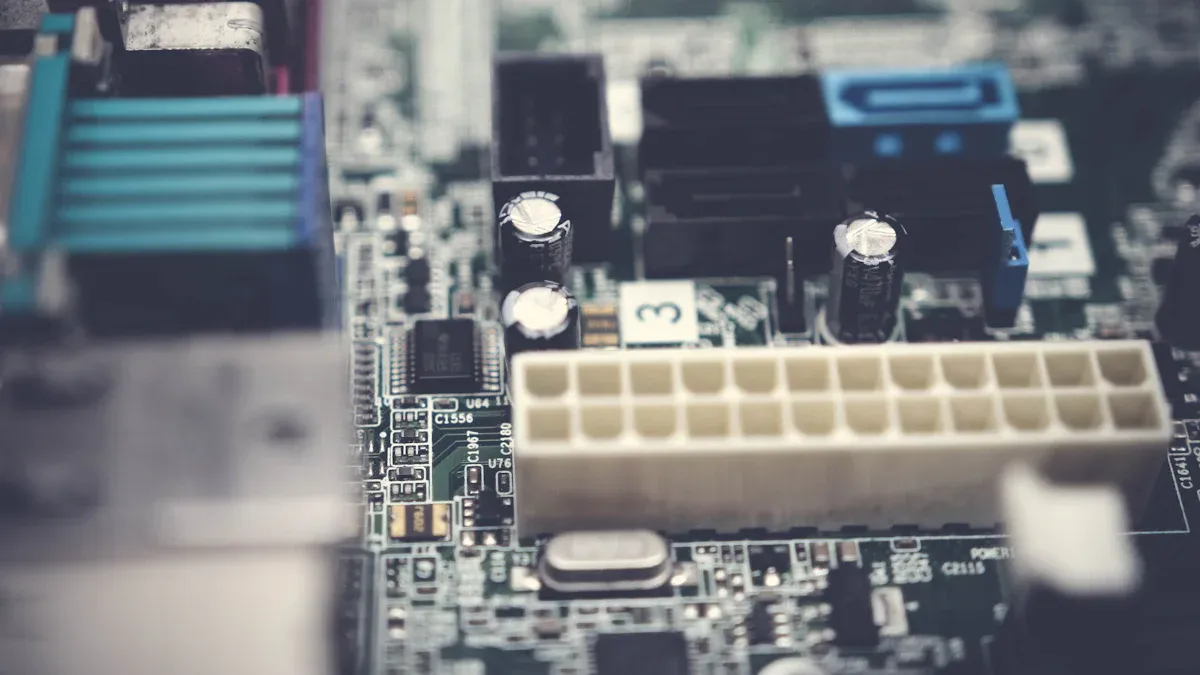How to Encapsulate Battery Cells with PET Tubing for Maximum Safety

For strong protection of your battery cells, battery cell encapsulation PET tubing is essential. Start by using battery cell encapsulation PET tubing to cover each battery cell. This provides excellent insulation and keeps your batteries safe from damage. Battery cell encapsulation PET tubing functions like heat shrink tubing, wrapping securely around every cell. The PET material in battery cell encapsulation PET tubing blocks out chemicals and moisture, ensuring your batteries remain protected. By choosing battery cell encapsulation PET tubing, you significantly improve the safety and durability of your battery insulation. Always make sure the insulation is applied evenly and avoid overheating. Effective protection comes from using the right battery cell encapsulation PET tubing and following proper procedures.
Key Takeaways
Wrap each battery cell with PET tubing for strong protection. This keeps out chemicals, water, and stops damage.
Clean the battery cells before you start. Check for any damage. Make sure all parts are lined up right before you cover them.
Cut the PET tubing a bit longer so it can overlap. Use a heat gun to shrink the tubing evenly. This makes the fit tight and safe.
Seal the ends of the tubing well. Look for holes or bubbles. This helps the battery stay safe and last longer.
Always wear safety gear like gloves and goggles. Do not overheat batteries or use ones that are damaged. This keeps you safe.
Why PET Tubing
Battery Insulation Benefits
You want your batteries to work well and be safe. PET layflat tubing gives strong insulation sleeving for battery cells. PET means polyethylene terephthalate. This material is very strong and does not let chemicals in. It also keeps out water, so your batteries do not get damaged. PET layflat tubing gives great electrical insulation. This helps stop battery cells from short-circuiting.
PET layflat tubing wraps each cell tightly. It makes a shield that blocks dust, water, and other bad things. You can trust this insulation to protect your batteries. Many people pick PET layflat tubing because it is light and simple to use. You can cut it to the size you need. You can also use heat to shrink it for a tight fit. PET layflat tubing is a top choice for battery insulation for beginners and experts.
Tip: Always look at your battery insulation sleeving for any holes or rips before you use your batteries.
PET Tubing vs. Other Materials
You have many options for battery insulation sleeving. Some people use PVC, silicone, or fiberglass tubing. Each type has good points. PET layflat tubing is strong, bends easily, and resists chemicals. PVC tubing costs less, but it does not handle heat as well as PET. Silicone tubing is soft and bends well, but it may not protect as much.
Fiberglass tubing is good for high heat, but it is harder to use. PET layflat tubing is easy to use and gives strong protection. You can use it for many battery insulation jobs. If you want good insulation, PET layflat tubing is a smart pick. It keeps battery cells safe and helps them last longer.
Materials and Tools

Battery Insulation Sleeving Options
You can pick from different battery insulation sleeving. The most common choice is pet layflat tubing. This tubing gives strong electrical insulation. It also keeps out chemicals and water. Pet layflat tubing works for many battery cells. It shrinks with heat for a snug fit. Many battery makers use it because it meets strict rules. Polyester heat shrink tubing, like pet layflat tubing, squeezes and insulates high-voltage battery parts. This makes your battery insulation sleeving safe and dependable.
Other sleeving types are also available. PVC tubing is cheaper but does not handle heat as well. Silicone tubing bends easily but may not protect as much. Fiberglass works for high heat but is harder to use. For a DIY fix, you can cut clean PET bottles or use layflat tubing from packaging. These can work if you need them, but pet layflat tubing is best for battery insulation sleeving.
Note: Experts test insulation materials to make sure they last and keep batteries safe, even in tough situations.
Tools and Safety Gear
You need the right tools and safety gear for battery insulation sleeving. Start with pet layflat tubing or heat shrink tubing. You also need scissors or a sharp blade to cut the tubing. Use a heat gun to shrink the pet layflat tubing around the battery cell. Always wear gloves and goggles to protect your hands and eyes. Anti-static clothing helps keep your work area safe from sparks.
Here is a quick table to help you get ready:
Item | Purpose |
|---|---|
Pet layflat tubing | Main insulation sleeving for battery cells |
Heat gun | Shrinks tubing for a tight fit |
Scissors/blade | Cuts tubing to the right size |
Gloves & goggles | Protects your hands and eyes |
Anti-static clothing | Reduces risk of static discharge |
Keep your workspace clean and check your tools often. Check your tools every month and watch them as you work. Good tools and safety gear help your battery insulation sleeving last longer and stay safe.
Encapsulation Steps

Prepare Battery Cells
Start by making sure your battery cells are ready for encapsulation. Clean each cell with a dry, lint-free cloth. Remove any dust or dirt. Check the battery for dents, leaks, or other damage. If you see any problems, do not use that cell.
You need to prepare your battery cells carefully. Here is a checklist to help you:
Align the electrodes. The anode should be a little bigger than the cathode. This helps prevent misalignment and keeps the battery safe.
Measure the amount of electrolyte. Use just enough to fill the battery, but not too much. Too much electrolyte can leak out and cause problems.
Control the pressure inside the cell. Use spacers that match the thickness of your battery parts. This keeps the pressure steady.
Mix the battery slurry well. Make sure the mixture is smooth and even. This helps the battery work better.
Check for moisture. Use a moisture meter or test kit. Batteries work best when they are dry.
Let the battery sit in a room with a steady temperature before you start. This helps the battery perform better.
Tip: Careful preparation gives your battery cell encapsulation pet tubing the best chance to provide strong protection.
Cut PET Tubing
Next, measure your battery cell. Use a ruler to find the length and height. Add these numbers together. Multiply the total by 1.1. This gives you extra length for overlap and shrinkage. Cut your PET tubing to this size. Leave 1-2 inches extra on each end. This extra space helps you get a tight seal.
Choose the right thickness for your tubing. Thicker tubing gives more protection, but it may be harder to shrink. Thinner tubing is easier to use, but it may not protect as much. Always use sharp scissors or a blade for a clean cut.
Note: Double-check your measurements before you cut. A good fit is important for battery cell encapsulation pet tubing.
Insert and Shrink
Slide the battery cell into the PET tubing. Make sure the tubing covers the whole battery, with extra on both ends. Hold the battery steady. Use a heat gun to shrink the tubing. Move the heat gun back and forth. Do not stay in one spot for too long. Even heat makes the tubing shrink smoothly.
Heat shrink tubing acts like a jacket for your battery. It keeps out water, dust, and dirt. It also gives electrical insulation and a neat look. Do not overheat the battery. Too much heat can damage the cell or melt the tubing.
Always keep the heat gun moving.
Watch for any bubbles or wrinkles.
If you see a problem, stop and let the battery cool.
Callout: Even heating is key. Uneven heat can cause weak spots in your battery cell encapsulation pet tubing.
Seal and Inspect
After shrinking, check the ends of the tubing. Fold or tuck the extra tubing over the ends of the battery. Use the heat gun again to seal the ends. This step keeps out moisture and gives extra protection.
Inspect your work. Look for holes, gaps, or loose spots. Press gently on the tubing to check for air bubbles. If you see any, use the heat gun to smooth them out. Make sure the battery cell encapsulation pet tubing fits tightly all around.
A good seal means better protection. Your battery will last longer and stay safe. If you want extra waterproofing, you can add a small amount of silicone caulk at the ends before sealing.
Reminder: Always let the battery cool before you use it. A cool battery is safer and works better.
Safety and Troubleshooting
Safety Tips
You must follow safety steps when using battery cell encapsulation PET tubing. Always put on gloves and goggles to keep your hands and eyes safe. Make sure your workspace is tidy and not messy. Never use batteries that are leaking or broken. If you notice swelling or a weird smell, stop working right away.
Tests show PET-based encapsulation with thermal bladders can stop burns if a battery fails. When a battery gets too hot, the PET layer grows bigger and makes a shield. This keeps the outside cooler than 48°C, which is safe for skin. You will not get burns or blisters with this system. It protects well without making the battery much bigger or heavier.
Tip: Let batteries cool down before you touch them after heat shrinking. This helps stop burns or damage.
Common Mistakes
People often make easy mistakes with battery insulation. Watch out for these:
Picking tubing that is too big or too small. If it does not fit right, it will not seal.
Using too much heat. Too much heat can hurt the battery or melt the insulation.
Not looking for holes or gaps after shrinking. Small holes let in water and dust.
Forgetting to wear gloves and goggles. Safety gear keeps you from getting hurt.
Using batteries that are bent or leaking. Damaged batteries are not safe.
Note: Check your work before you use the battery. Careful checking stops most problems.
Troubleshooting Issues
Problems can happen even if you do everything right. Here are some common problems and how to fix them:
Tubing does not shrink the same everywhere: Move the heat gun slowly and keep it at the right space.
Air bubbles under the tubing: Use soft heat and press out bubbles with a cloth.
Tubing rips or breaks: Try thicker tubing or cut with sharper scissors.
Battery gets too hot: Let it cool and look for damage before trying again.
Case studies show most battery problems come from bad design or rough use. Quality checks like x-ray tests and careful handling have stopped many accidents. If you see damage or feel unsure, get a new battery or try another way. Good insulation and careful work help your batteries stay safe and last longer.
You have learned how to encapsulate battery cells with PET tubing for strong safety. Follow these steps:
Prepare and inspect each battery cell.
Shrink and seal the tubing.
Check your work for gaps or damage.
Always double-check your insulation. Safe batteries last longer and work better.
If you want to learn more, look for guides on advanced battery sleeving or join online battery safety forums.
FAQ
How do you choose the right size PET tubing for your battery?
Measure your battery’s length and diameter. Add 10% to your measurements for overlap and shrinkage. Pick tubing that fits snugly but does not squeeze the battery. Double-check your measurements before you cut.
Can you use a hair dryer instead of a heat gun?
A hair dryer does not get hot enough for PET tubing. You need a heat gun for proper shrinking. Using a hair dryer may leave the tubing loose or uneven.
What should you do if the tubing has wrinkles after shrinking?
Tip: Use the heat gun again and move it slowly over the wrinkled area. Keep the gun moving to avoid overheating. Press gently with a cloth while heating to smooth out wrinkles.
Is PET tubing safe for all battery types?
You can use PET tubing for most cylindrical and prismatic batteries. Always check the battery’s temperature rating and chemical compatibility. Some special batteries may need different insulation.
How do you store leftover PET tubing?
Store PET tubing in a cool, dry place. Keep it away from sunlight and sharp objects. Use a sealed bag or box to prevent dust and moisture from getting in. 😊
See Also
Top Uses Of Ultrathin PET Heat Shrink Tubing In Medicine
Building Multi-Layer Catheters With Medical Grade FEP Tubing
Essential Facts About PET Heat Shrink Tubing For Electronics
The Importance Of Ultra-Thin PET Tubing In Medical Devices
Significance Of Gamma Radiation Resistant Tubing In Medical Use

